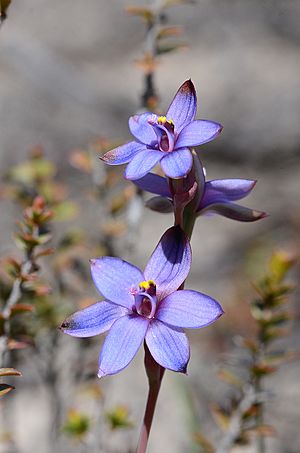Azure sun orchid facts for kids
Quick facts for kids Azure sun orchid |
|
|---|---|
 |
|
| Thelymitra azurea in the Little Desert National Park | |
| Scientific classification | |
| Genus: |
Thelymitra
|
| Species: |
azurea
|
The azure sun orchid (Thelymitra azurea) is a beautiful type of orchid that grows only in south-eastern Australia. It has a single thick, grass-like leaf. Its flowers are a striking dark azure blue with darker lines, and there can be up to ten flowers on one plant. The top part of its anther (a part of the flower that holds pollen) has a bumpy or jagged tip.
What Does the Azure Sun Orchid Look Like?
The azure sun orchid is a special kind of plant that grows from a tuber (a swollen underground stem, like a potato). It is also a perennial plant, meaning it lives for more than two years. It has one straight, thick, dark green leaf that is folded in half lengthwise. This leaf can be about 100–270 mm (4–10 in) long and 3–8 mm (0.1–0.3 in) wide.
Up to ten dark azure blue flowers grow on a stem that can be 130–450 mm (5–20 in) tall. These flowers have darker veins and are about 13–27 mm (0.5–1 in) wide. The sepals and petals (parts of the flower that look like petals) are about 6–13 mm (0.2–0.5 in) long and 3–7 mm (0.1–0.3 in) wide.
The central part of the flower, called the column, is blue to purplish. It is about 2.5–4.5 mm (0.1–0.2 in) long and 2 mm (0.08 in) wide. The top part of the anther has a short, dark purplish tip that looks bumpy or jagged and is yellow. The side parts of the column have white or purplish tufts that look like mops. These orchids rely on insects to help them pollinate. Their flowers usually open on warm, sunny days. You can see them flowering from September to December.
How Was the Azure Sun Orchid Named?
The azure sun orchid was officially described for the first time in 1917. This was done by a person named R.S. Rogers. His description was published in a scientific journal called Transactions and Proceedings of the Royal Society of South Australia.
The second part of its scientific name, azurea, comes from a Latin word. This Latin word is a version of the French word azure, which means "a blue colour". This name was chosen because of the beautiful blue colour of its flowers.
Where Do Azure Sun Orchids Grow?
The azure sun orchid grows in special areas called heathlands and forests. You can find this orchid in western Victoria and in the south-eastern part of South Australia. It also grows on Kangaroo Island.

